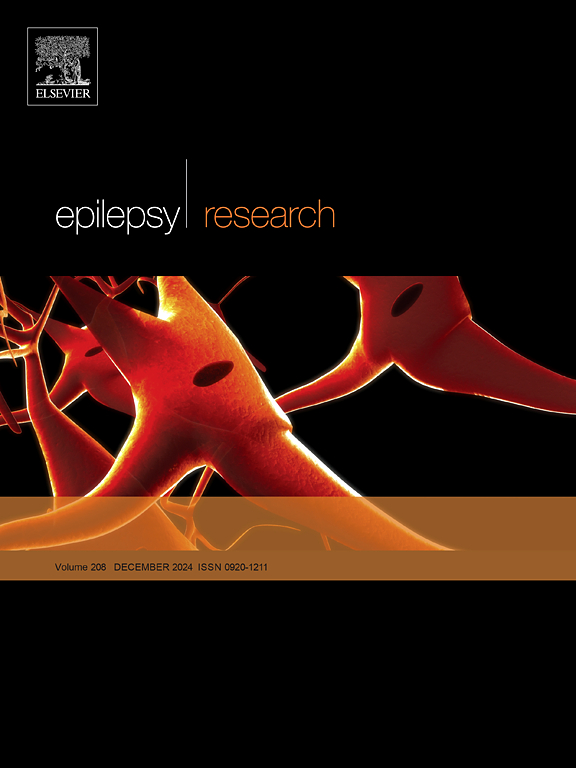Adequate and inadequate dosing of anti-seizure medications in status epilepticus
IF 2
4区 医学
Q3 CLINICAL NEUROLOGY
引用次数: 0
Abstract
Background
Status epilepticus (SE) is defined as five or more minutes of continuous seizures or two or more discrete seizures with incomplete recovery of consciousness.1 The incidence of SE in the United States ranges from 18.3 to 41 per 100,000 patients per year2. Reviews of SE clinical literature demonstrate that 70–75 % of patients did not receive an adequate dose of benzodiazepine according to clinical guidelines. Underdosing of benzodiazepines increases the risk of refractory SE and unfavorable outcomes.8–9
Methods
This single center retrospective cohort study evaluated the dosing of benzodiazepines and other anti-seizure medications in adult patients with SE. The primary outcomes were incidence of breakthrough seizures in patients with appropriate dosing benzodiazepines compared to inappropriate dosing of benzodiazepines within 24 h of the first dose and incidence of breakthrough seizures in patients with appropriate loading dose of maintenance anti-seizure medication compared to inappropriate loading dose of anti-seizure medication within 24 h of the first dose.
Results
Thirty-eight patients received adequate benzodiazepine dosing compared to 155 with inadequate dosing. Eighty-seven percent of patients with adequate dosing of benzodiazepine experienced a breakthrough seizure compared to 84 % of patients with inadequate dosing (p = 0.62). Sixty-three percent of patients with adequate dosing of benzodiazepines required first non-benzodiazepine anti-seizure medication compared to 63 % of patients with inadequate dosing (p = 0.76). Breakthrough seizures within 24 h after the first load of non-benzodiazepine anti-seizure medication occurred in 21 % of patients in the adequate dosing group compared to 28 % in the inadequate dosing group (p = 0.73).
Conclusion
While benzodiazepines and rescue anti-seizure medications are frequently underdosed in patients with status epilepticus, there was no difference in recurrent seizures comparted to those with adequate dosing.
癫痫持续状态中抗癫痫药物的适当和不适当的剂量
背景:癫痫持续状态(SE)定义为连续发作5分钟或更长时间,或两次或两次以上不完全恢复意识的离散性发作在美国,SE的发病率为每年每10万患者18.3 - 41例。对SE临床文献的回顾表明,70 - 75% %的患者没有按照临床指南接受足够剂量的苯二氮卓类药物。苯二氮卓类药物剂量不足增加难治性SE和不良结局的风险。方法本研究为单中心回顾性队列研究,评估苯二氮卓类药物及其他抗癫痫药物在成年SE患者中的应用。主要结局是首次给药后24 h内,适当剂量的苯二氮卓类药物与不适当剂量的苯二氮卓类药物的突破性发作发生率,以及首次给药后24 h内,适当负荷剂量的维持性抗癫痫药物与不适当负荷剂量的抗癫痫药物的突破性发作发生率。结果苯二氮卓类药物剂量充足者38例,剂量不足者155例。苯二氮卓类药物剂量充足的患者中有87%出现突破性发作,而剂量不足的患者中有84% % (p = 0.62)。服用足够剂量苯二氮卓类药物的患者中,63%需要首先服用非苯二氮卓类抗癫痫药物,而服用剂量不足的患者中,这一比例为63% % (p = 0.76)。在首次服用非苯二氮卓类抗癫痫药物后24 h内,21. %的患者出现突破性癫痫发作,而不充分剂量组的这一比例为28. % (p = 0.73)。结论虽然苯二氮卓类药物和抢救抗癫痫药物在癫痫持续状态患者中经常使用不足,但与剂量充足的患者相比,复发性癫痫发作没有差异。
本文章由计算机程序翻译,如有差异,请以英文原文为准。
求助全文
约1分钟内获得全文
求助全文
来源期刊

Epilepsy Research
医学-临床神经学
CiteScore
0.10
自引率
4.50%
发文量
143
审稿时长
62 days
期刊介绍:
Epilepsy Research provides for publication of high quality articles in both basic and clinical epilepsy research, with a special emphasis on translational research that ultimately relates to epilepsy as a human condition. The journal is intended to provide a forum for reporting the best and most rigorous epilepsy research from all disciplines ranging from biophysics and molecular biology to epidemiological and psychosocial research. As such the journal will publish original papers relevant to epilepsy from any scientific discipline and also studies of a multidisciplinary nature. Clinical and experimental research papers adopting fresh conceptual approaches to the study of epilepsy and its treatment are encouraged. The overriding criteria for publication are novelty, significant clinical or experimental relevance, and interest to a multidisciplinary audience in the broad arena of epilepsy. Review articles focused on any topic of epilepsy research will also be considered, but only if they present an exceptionally clear synthesis of current knowledge and future directions of a research area, based on a critical assessment of the available data or on hypotheses that are likely to stimulate more critical thinking and further advances in an area of epilepsy research.
 求助内容:
求助内容: 应助结果提醒方式:
应助结果提醒方式:


